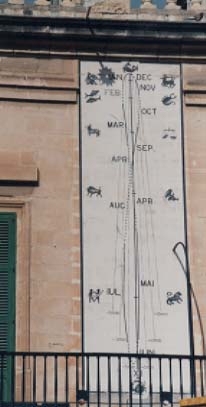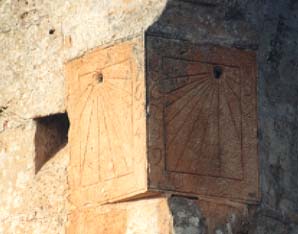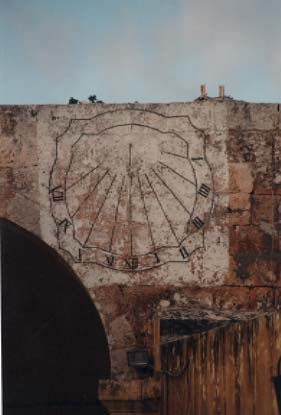 For
a full overview click
here
For
a full overview click
here  For
a full overview click
here For
a full overview click
here Malta sundial trailby Joe Azzopardi |
|---|
| The Maltese archipelago consists of a group of three islands Malta, Gozo and Comino. The Islands are located south of Sicily and are considered the closest point of Europe to North Africa. They have a long and variegated history. Malta come directly, and definatly, under Europen influence when it was given to the knightly Order of St. John in 1530. These were expeled in 1798 by Napolion while he was on his way to Egypt. The Maltese rebeled agains the French after two months and managed to expel them after two years with the help of the British that become the new overlords. Malta became an independent state in 1964. Public transport in Malta is relatively easy to use and certainly inexpensive. Most routes depart from Valletta Terminus. All locations will be indicated with their respective route number. The sundials referred to are the most easily traceable. There are in all 55 recorded, ancient or monumental, sundials in Malta, apart from specimens in private property.  Not
withstanding its rather small size Malta holds a considerable heritage.
One of its main architectural features are a number of Prehistoric Temples
dating back to 5000 B.C. Among these are the complex of Har Qim (Stones
of Worship) and Mnajdra. (3000-2500 B.C.). This period represented the
climax of the Temple civilisation. The Mnajdra Temple is built in such
a way so as to mark the beginning of every season through the concentration
of light within the structure. Mnajdra is in the Zurrieq/ Qrendi (bus
no. 38 or 138) area. Close to these Temples, on the road to the village
of Qrendi, there is a two face, square sundial jetting out of the corner
of a farm building in Ghajn ix-Xemx (Sources of the Sun) Street (pictured
right). The area is also particularly scenic and offers beautiful views
of the coast. Not
withstanding its rather small size Malta holds a considerable heritage.
One of its main architectural features are a number of Prehistoric Temples
dating back to 5000 B.C. Among these are the complex of Har Qim (Stones
of Worship) and Mnajdra. (3000-2500 B.C.). This period represented the
climax of the Temple civilisation. The Mnajdra Temple is built in such
a way so as to mark the beginning of every season through the concentration
of light within the structure. Mnajdra is in the Zurrieq/ Qrendi (bus
no. 38 or 138) area. Close to these Temples, on the road to the village
of Qrendi, there is a two face, square sundial jetting out of the corner
of a farm building in Ghajn ix-Xemx (Sources of the Sun) Street (pictured
right). The area is also particularly scenic and offers beautiful views
of the coast. Valletta, the capital city, has two sundials. One of these is on the back of the Jesuits Church in St. Paul’s Street. This is one of Malta’s oldest and has to be looked for with tenacity. Most people in the street will be happy to point it out to you. The other sundial was contracted on Republic Street, in the heart of the city.  The face (6.1m x 1.9m, pictured left) includes an analemma and Zodiacal
signs. It marks only noon time. This is on the façade balcony of a building
known as the Casino Maltese, close to the palace of the Grand Masters.
Its designer was Rev. George Fenech who constructed quite a few sundials
across Malta.
The face (6.1m x 1.9m, pictured left) includes an analemma and Zodiacal
signs. It marks only noon time. This is on the façade balcony of a building
known as the Casino Maltese, close to the palace of the Grand Masters.
Its designer was Rev. George Fenech who constructed quite a few sundials
across Malta. Just outside the city of Valletta lies its suburb called Floriana (bus ALL). Within this suburb there is a Franciscan convent. This has attached to it a lovely museum within which there is an old sundial dated 1782.(0.55m x 0.55m). This was removed from a house in Siggiewi and brought here in 1970. The complex also includes an interesting underground cemetery that has been recently restored. Anticipated booking is necessary prior to visits. Another two of Rev. Fenech’s Dials can be seen in the village of Qormi (bus 88,89,91). One is on the external parameter of St. Sebastian Church. ((3.63m x 2.70m) and includes an inscription in Maltese that translates into "He Created The Sun to Rule Over The Day". The other is on a private residence in Anici Street (1.67 x 1.20m). This second example includes an analemma for each of the eight hours it marks and instructions on their use depicted on the face. A third sundial in the village lies on the left side, looking at the façade, of the parish church of St. George (1.70 x 1.50). Qormi is also famed for its numerous bakeries. One should seriously consider some traditional Maltese bread while visiting the village. The greatest concentration of Sundials in Mlata occurs in the village of Rabat. This is close to the old capital, Mdina (bus 81,84,65,86). There are in all twelve of them. Five of these are distributed around the courtyard of the Dominicans Priory. Fr. Castronius designed four of these in 1717. They were later restored by Fr. Calcedonius Gulia, a capuchin friar, in 1822. He was also responsible for the fifth sundial in the court. This is a meridian (2.60m x 1.5m). Another Rabat sundial, can be seen on the servants quarters at Verdala Palace (0.8m x 0.8m). The Palace was built by Grand Master Verdala and subsequently used as summer residence of the Grand Masters. This is surrounded by the beautiful Boschetto Gardens.  Mellieha (bus 44,45,48), which is the northern most village of the Island
has a beautiful sundial (pictured left) in the court outside the Sanctuary
of Our Lady within the parish church complex (1.67 diameter circa). A
modern sundial can be seen on the exterior of Dar l-Arlogg Tax-Xemx (House
of the Sundial) in Sardinella street. Within the limits of Mellieha there
is also Ghadir Bay which is very popular with Maltese and foreigners.
Mellieha (bus 44,45,48), which is the northern most village of the Island
has a beautiful sundial (pictured left) in the court outside the Sanctuary
of Our Lady within the parish church complex (1.67 diameter circa). A
modern sundial can be seen on the exterior of Dar l-Arlogg Tax-Xemx (House
of the Sundial) in Sardinella street. Within the limits of Mellieha there
is also Ghadir Bay which is very popular with Maltese and foreigners.
A slightly out of the way sundial can be seen at the corner, on the roof of a chapel on what is know as Laferla Cross Hill, limits of Siggiewi (bus 89). The dial has a form that is typical of most old Maltese sundials. The view from the top of the hill is certainly worth the somewhat tough climb. The village of Siggiewi is also worth a visit offering a typical Maltese village setting. The neighbouring village of Zebbug has a lovely sundial outside a house in Triq il-Kbira (Main Street). This is round in shape and was carved out Globigerina, the local soft limestone. . |